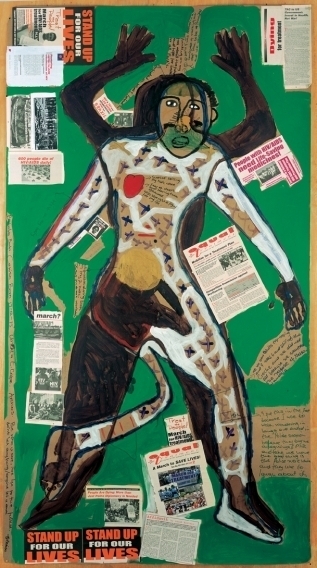Body map 4
| CCAC #: | 0370 |
| Artwork title: | Body map 4 |
| Artist(s): |
Babalwa Cekiso |
| Year made: | 2002 |
| Artwork type: | Paper |
| Medium: | Digital inkjet print on paper |
| Framed dimensions (in mm): | 950 x 610 |
| Artwork series: |
Long Life Project Body Maps |
| Source: | Bought by the Artworks Committee from David Krut |
| Year acquired: | 2004 |
| Installation type: | Movable artwork |
| Current location: | On private display |
| Signage: | Babalwa worked as a Treatment Action Campaign (TAC) volunteer in Khayelitsha, after finding out she was HIV positive around the time of the first TAC march in 2001. When she first saw body maps, she felt that those who were on ARV treatment were lucky and should not hide their faces. She went on to work in HIV/AIDS therapy initiatives. Babalwa Cekiso's statement I am Babalwa Cekiso. I live and work as a TAC volunteer in Khayeltisha. One day I saw this white guy hanging photos and huge body maps on the walls of the Mew Way Recreation Hall. I looked at these photos – of my doctor, Themba, of the streets of Khayelitsha, and of people taking their medicines – and I looked at the body maps. I went up to the guy and said, ‘I really like this work, but who are these people in the photos? Why are they hiding their faces? They’re so lucky to get ARV treatment when most of the country and Africa hasn’t got it. They can’t hide their faces, it’s like taking the money and running. I’m HIV positive, and I believe we mustn’t hide if we are one of the lucky ones to get treatment.’ After that I joined the Memory Box project as coordinator of the A-team women who tell their stories in this book. A-team members work for themselves in an HIV cooperative. They don’t only sell beaded AIDS ribbons like most HIV support groups, they sell their expert knowledge – what they know from the inside about HIV and AIDS. They also organise focus groups for researchers, conduct questionnaires and do translations. But the main thing they do is run Memory Book and Memory Box support groups. Now, after Long Life, they teach people how to do body maps to understand their own bodies and treatment. When I look at this body map I feel like my life is not finished. I feel good actually, explaining how I feel inside, certain feelings and memories that I don’t normally talk about. TAC is getting everybody to do what they should be doing, fighting for their lives and what they believe is right for them. When I look at my body map it reflects the life of activism. That is why one foot is up in the painting. It shows the strength that I have everyday to fight for my life and others. |

Photographer: Unrecorded
Photo copyright: Consult with CCT curatorial team
NOTE: The process of photographing artworks in the CCAC is underway - we are currently working to improve image quality and display on the CMS but have included internal reference photos for identification purposes in the interim.